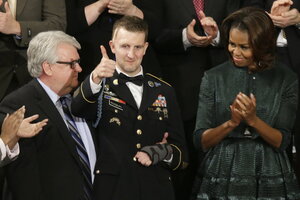Who is Cory Remsburg? And what does he mean to Obama?
President Obama rounded out his State of the Union speech with the story of Cory Remsburg, the gravely wounded soldier who has made an astounding comeback.

Army Ranger Sgt. 1st Class Cory Remsburg acknowledges applause from first lady Michelle Obama and others during President Obama's State of the Union address on Capitol Hill in Washington on Tuesday.
J. Scott Applewhite/AP
Cory Remsburg has taken 10 tours of Iraq and Afghanistan. He has won a Purple Heart, received a Bronze Star, and made an astounding comeback from an almost-fatal wounding in Afghanistan. And, on Tuesday, he was a guest of honor at President Obama’s State of the Union speech, his story the stirring, poignant conclusion to Mr. Obama’s address to the nation.
Michelle Obama’s seating box at the speech, as is tradition, was filled with people who represent themes that the president addressed in his speech, each one a tangible reminder, often with an emotional lilt, of what Obama has accomplished or still hopes to accomplish in office.
Mr. Remsburg, seated to Mrs. Obama’s right, was the final invitee to get Obama’s nod Tuesday evening, receiving the audience’s longest standing ovation of the evening.
In concluding the address with Remsburg’s story, and with a promise of support for returning soldiers, Obama appeared to round out the speech with a raw, affecting note that both Democrats and Republicans, in an unusual moment of unity these days, could get behind.
But Remsburg’s story, as Obama told it, also appeared to be an exclamation point to a broader theme that the president pressed throughout the speech: that second chances are possible, not just for gravely wounded veterans, but for a battered president, too, as he tries to get legislation through Congress and seeks to mend weak approval ratings.
“Like the Army he loves, like the America he serves, Sgt. 1st Class Cory Remsburg never gives up, and he does not quit,” Obama said near the end of his speech. “My fellow Americans, men and women like Cory remind us that America has never come easy.”
In his speech, Obama said that he first met Remsburg, now in his early 30s, on the 65th anniversary of D-Day – June 6, 2009 – at a commemorating event at Omaha Beach in France, where Remsburg and seven fellow Army Rangers were reenacting a parachute drop. Remsburg had joined the Army on his 18th birthday, after his father, Craig Remsburg, refused to sign the paperwork needed for him to join at age 17, Time magazine reported.
The elder Remsburg, a retired Air Force Reserve firefighter, was seated to his son’s right during the State of the Union address.
At that 2009 meeting, Obama found the Ranger “a strong, impressive young man, with an easy manner, sharp as a tack,” Obama said during the speech. The two “joked around and took pictures,” and Obama told him to keep in touch.
A few months later, on Oct. 1 in Kandahar, Afghanistan, Remsburg was almost killed by a roadside bomb. He was found facedown in a canal, underwater, with shrapnel in his brain, according to Obama. It was Remsburg’s 10th tour in Afghanistan and Iraq.
Remsburg was in a coma for months. When Obama came to visit the soldier in April 2010 at a military hospital in Washington, D.C. – the second time that the two had met – the wounded man couldn’t speak and could barely move, the president said.
But, in the pair’s third meeting last August, in Phoenix, Remsburg “did something that neither Mr. Obama nor military doctors would once have predicted: he stood up and saluted his commander in chief,” The New York Times reported that month, in a feature on Obama’s relationship with the recovering solider.
Remsburg, following dozens of surgeries and unknown hours of rehab, is still blind in one eye, still struggling to move his left side, Obama said in his speech.
Yet Remsburg still hopes to return to the armed forces, the president said. Getting there will not be easy, but “nothing in life that's worth anything is easy," Obama said Remsburg told him.
Though Obama often meets with injured soldiers returning from Iraq and Afghanistan – he has met with about 1,000 – his relationship with Remsburg is unusual for the sheer number of meetings: Obama has not met personally with any other veteran more than twice, The New York Times said in August.
The relationship is unusual, too, for the number of times that Obama has deployed the man as a symbolic note in his speeches. The president has called upon the injured, but persevering solider, as a stand-in for all American military personnel, whom he has promised to support, in at least two other speeches – at the Disabled American Veterans' conventions in the summers of 2010 and 2013, according to The New York Times.
In the State of the Union speech, Remsburg appeared to do double symbolic duty, representing not just Obama’s commitment to veterans, but, more broadly, to his promise to work harder at pushing through Congress the policies and programs around which he wrapped his 2008 and 2012 campaigns.
"Sometimes we stumble; we make mistakes; we get frustrated or discouraged,” he said, just after invoking Remsburg’s example. “But for more than 200 years, we have put those things aside and placed our collective shoulder to the wheel of progress.”
Obama has been chastised for stalling last year on promised action on gun laws and immigration issues, among other things. He used his State of the Union speech to reiterate a commitment to prodding Congress, as well as to – when able – signing executive orders to get things done.

